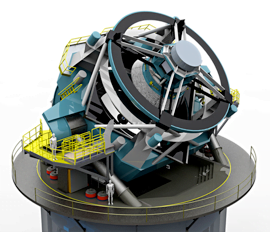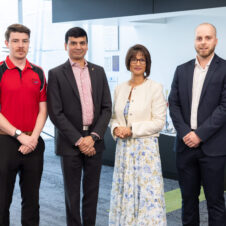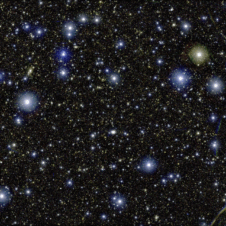
A 2010 rendering of the LSST, a proposed 8.4-meter ground-based telescope that will survey the entire visible sky deeply in multiple colors every week from a mountaintop in Chile. Image credit: LSST Corporation/NOAO).
Super-sized telescopes currently under development around the world like the Square Kilometre Array (SKA) radio telescope, the Large Synoptic Survey Telescope (LSST) and the Murchison Widefield Array (MWA), will be so sensitive that information from the rest of the Universe will literally pour from the sky. Once these data intensive telescopic beasts come online the challenge for astronomers will no longer be to find the needle in the haystack, but to remove the hay from the pile of needles and choose which are the most likely to further our understanding of the cosmos.
To tackle this data challenge head on, two organisations on opposite sides of the planet have joined forces. The LSST Corporation in the United States and the International Centre for Radio Astronomy Research (ICRAR) in Perth, Western Australia have signed an agreement to work together on designing common database systems for optical and radio astronomy and research tools that will enable direct comparisons of objects discovered by these optical and radio telescopes.
ICRAR Director Prof. Peter Quinn said “ this collaboration will give us a great head start in preparing for the enormous data challenges of the SKA and will allow scientists access to both optical and radio data to probe the Universe across all wavelengths”
The LSST was ranked the number one project in the US by the Astronomy and Astrophysics Decadal Survey conducted in 2010. Data Management Project Manager, Jeff Kantor said “Once you have separated the incoming data into sources and objects, it makes little difference to the system if the signal is at optical or radio wavelengths. So it makes sense to join forces with ICRAR to find data processing solutions for the enormous databases that will be generated by both of these amazing telescopes.”
Using supercomputers located at the new Pawsey Centre in Perth, ICRAR’s Professor Andreas Wicenec is heading up the international team designing data systems for the SKA radio telescope. “We expect to detect more than 100 billion objects, which is at least 10 times more than we’ve observed in the last 400 years of astronomy. This represents an immense challenge but potentially huge scientific reward“, said Professor Wicenec.
For comment contact:
Professor Peter Quinn, ICRAR Director | The University of Western Australia
Tel: +61 8 6488 4553, Mobile: +61 414 185 052, Email: peter.quinn@icrar.org

